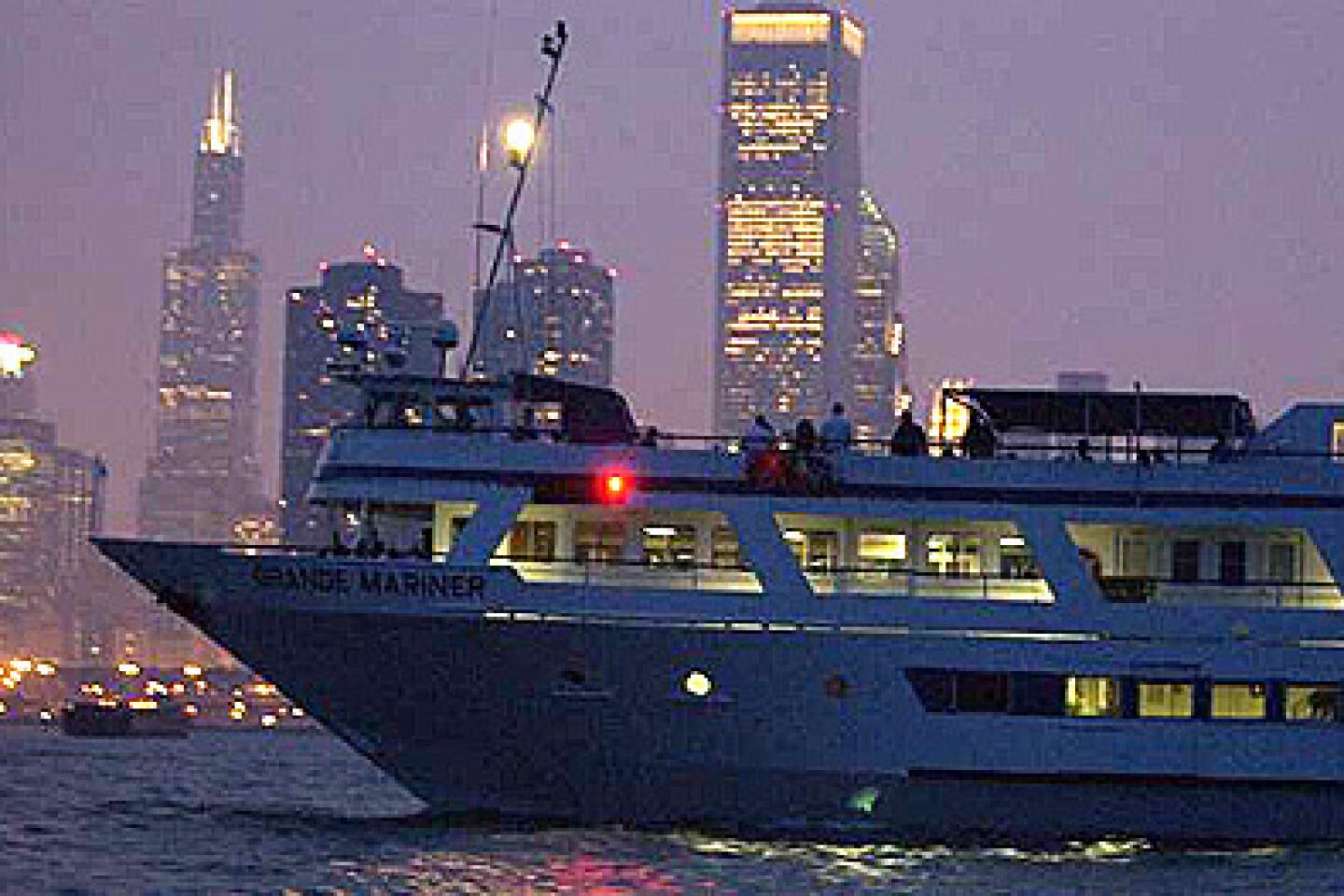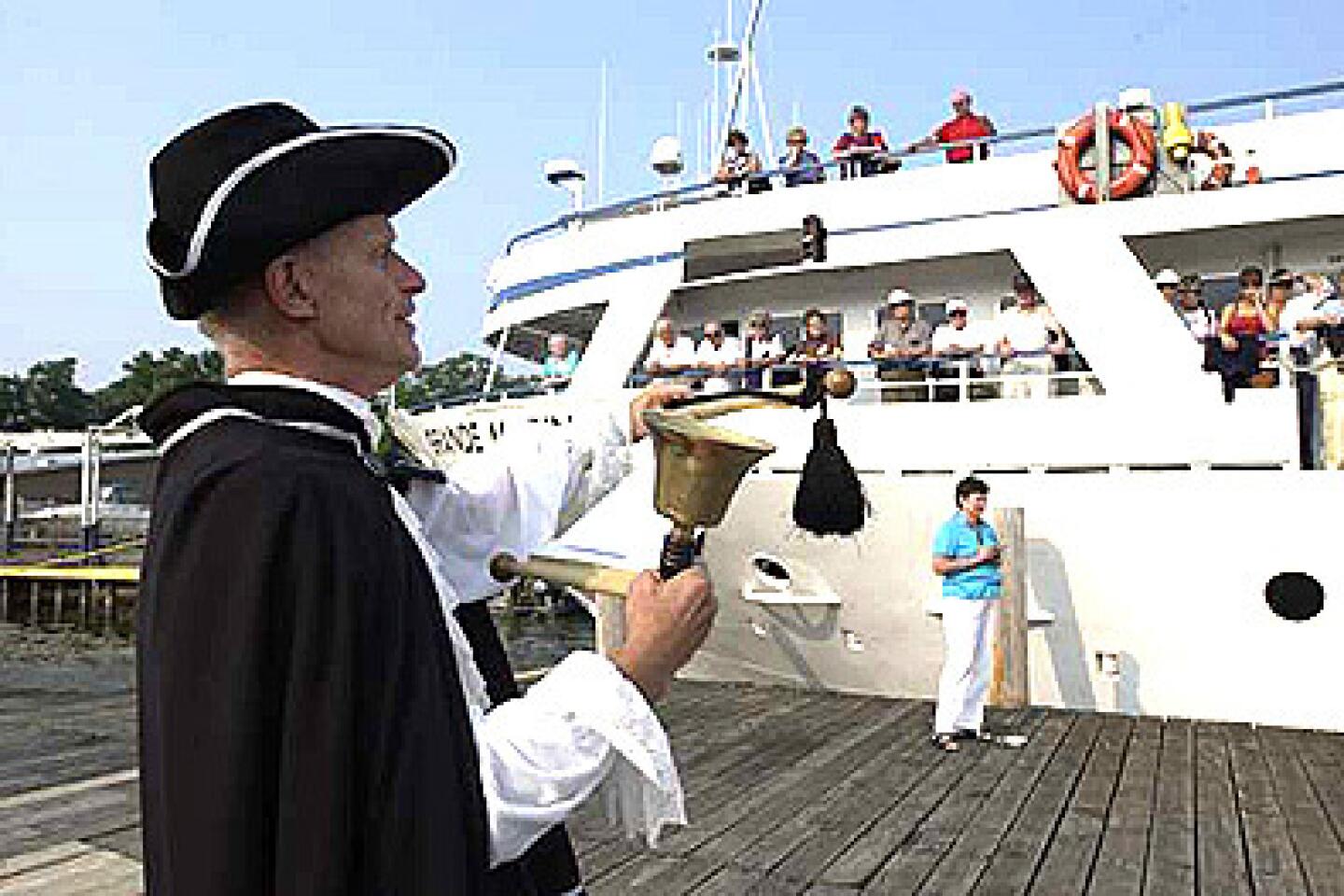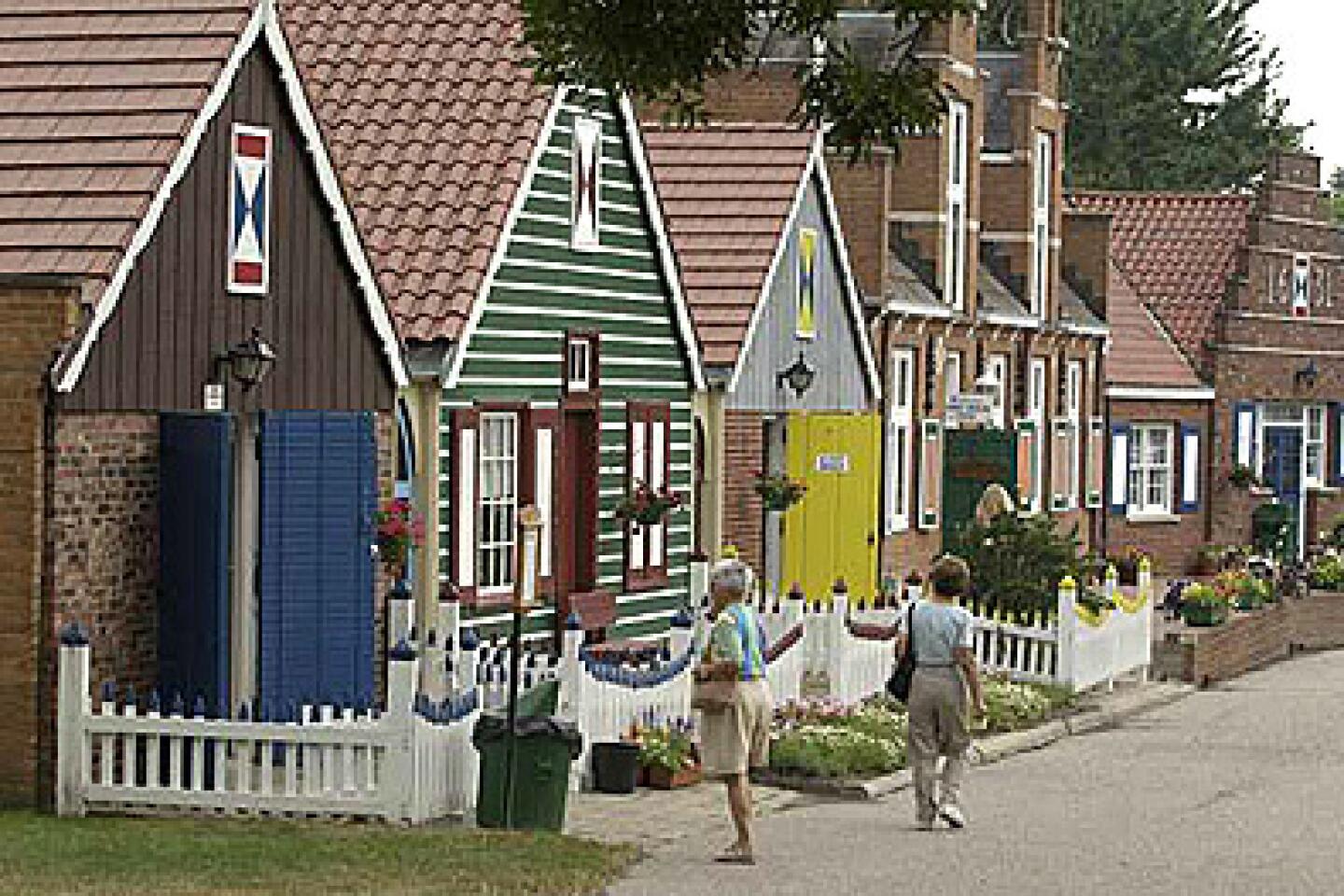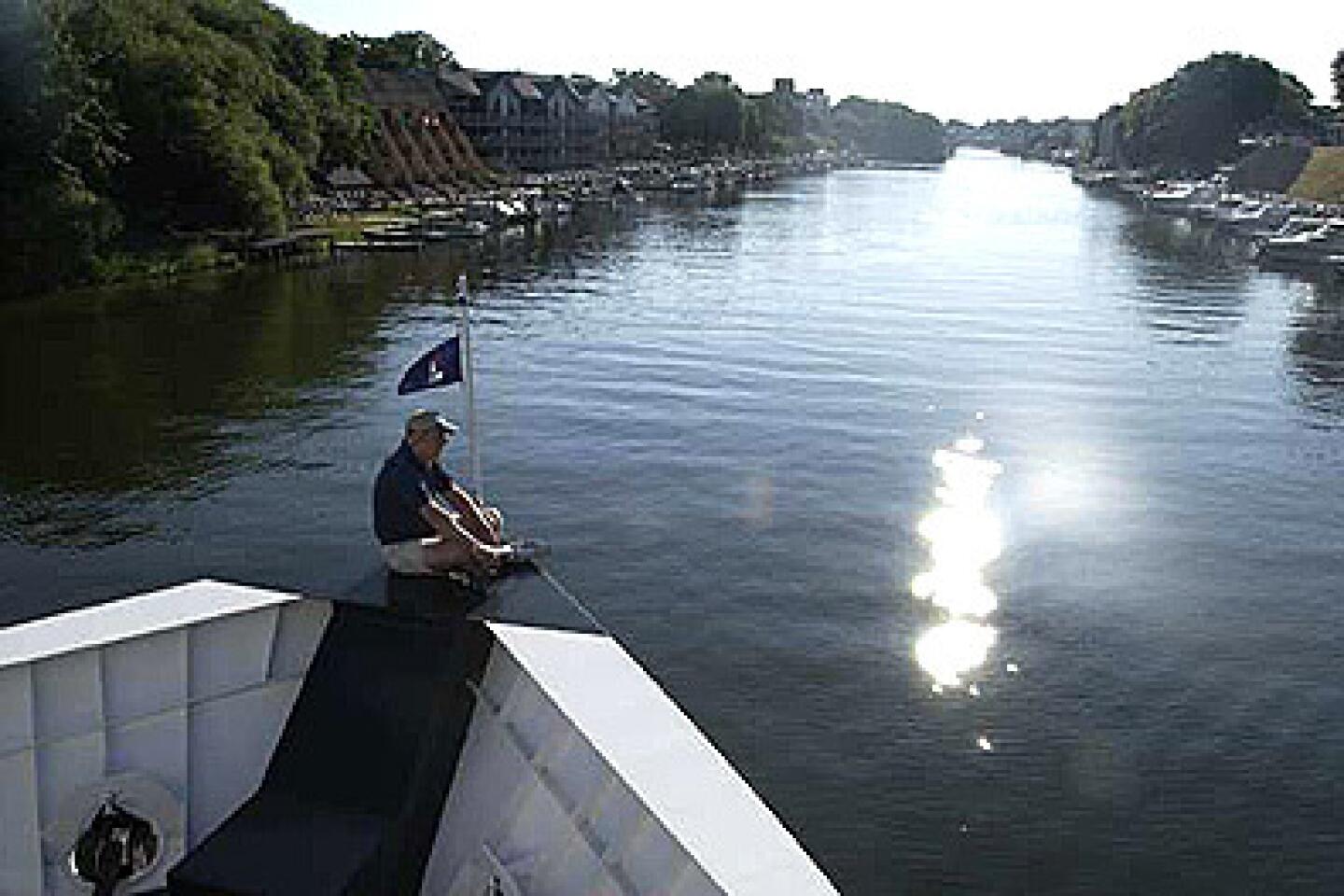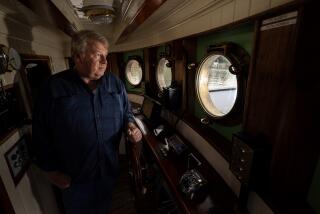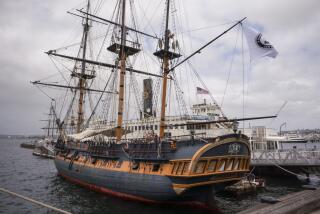A shipshape way to see Lake Michigan
CHICAGO — A small but devoted group of cruise aficionados wouldn’t book a trip on a big ship -- even if you offered them free shore excursions or an upgrade to a stateroom on the top deck. Not for them the swimming pools, floor shows and shopping arcades of glitzy mega-ships. They want simpler pleasures: a chance to watch the crew work, see the sights up close and make friends with nice regular folk -- the way I did last July on a six-night Lake Michigan cruise aboard the American Canadian Caribbean Line’s Grande Mariner.
Cruising Lake Michigan, with its sailboats, lighthouses and dunes, sounded appealingly easy: embarkation and disembarkation in Chicago, no passports, foreign languages or currency required. And I liked the sampling of old-fashioned hometown America provided by the itinerary: Holland, Manistee and Mackinac Island, Mich., followed by Sturgeon Bay, Wis., and Milwaukee.
I persuaded my father, John, and family friends, Virginia and Joe Jeffers of Bethesda, Md., to come along. Unfortunately, my father fell ill and couldn’t go. But the Jefferses made excellent travel companions. Joe, a large, lanky Alabaman in his 90s, could charm open an oyster, and Virginia has a sophisticated sense of humor. Assessing shore excursion choices, she said wryly, “I confess, I never had a strong inclination to see Milwaukee.”
We arrived in Chicago the day before the ship sailed. For a reasonable $95 each, we ate meals and spent an extra night on the Grande Mariner, tied up along the north side of Navy Pier.
Like its two sister ships, the Niagara Prince and Grande Caribe, the Grande Mariner is small, accommodating about 100 passengers and 20 crew members, with tiny cabins and limited public space. But its diminutive size is an open sesame to inland waterways, letting it navigate tight spots on rivers, narrow channels and locks in canals.
The concept of small ship cruises on rivers and canals is well established in Europe but less common here. The line’s founder, Capt. Luther H. Blount, got the idea in 1958 when he took a group of friends on a trip in his swordfishing boat. They sailed north along the Eastern Seaboard, up the St. Lawrence River, through the Erie Canal and Hudson River to New York City, then back to Rhode Island. The cook was Blount’s wife, the shipboard attendants his daughters. (He has four, all of whom learned to weld at his shipyard.) At the end of the voyage, a passenger clinked his fork against a glass and said, “This has been one of the best vacations I ever had, only next time I want to pay for it.”
Blount’s daughters chimed in, “Yeah, Daddy, and you can pay us too.”
Spartan cabin and bath
Our cabins -- on the second level of four, near the dining room -- were about the size of a large walk-in pantry. The staterooms were fine for a single like me, but tight for two adults. The berths were narrow and tolerably firm, made up in floral spreads. There were no pictures on the walls, but portholes; cubbies and hooks for clothes; furniture that would fit well in a church rec room. Baths were Continental-style aluminum chambers with a sink and toilet and about a yard of space in between, for taking showers. To do so, you pulled a curtain around, creating a stall, and used a hand-held water nozzle. This arrangement left the floor, which had a drain, wet after ablutions.
I fared fine, having cruised on small ships in Alaska and the Netherlands. But Virginia tripped over the metal lip separating the bath from the cabin, and Joe found the accommodations far more constricting than those of the ship he served on during World War II.
People who had cruised with the line before were unfazed. (Sixty percent of all ACCL cruisers are repeat passengers.) They already knew it made sense to spend most of the time on the observation deck or in the window-lined lounge on the third level of the ship. It has padded banquettes, upholstered chairs, couches, a big-screen TV, a little library, an organ and an empty bar.
The bar didn’t stay empty for long. As passengers arrived, it filled up with bottles of booze, each neatly labeled with the cabin number of the owner, per the ship’s BYOB policy. (Nonalcoholic drinks, setups and all meals were included in the price of the cruise.)
With the Grande Mariner scheduled to depart Chicago at 8 p.m., Virginia and I had time to sample a few of the city’s attractions while Joe stayed on board, getting to know new arrivals.
The temperature was nudging 100 degrees. Undaunted, Virginia and I walked around Navy Pier, completed in 1916, then caught a water taxi along the shorefront to the Field Museum, a grand old Chicago dowager that opened in 1894, dedicated to natural history. Virginia visited the ancient Egypt and Native American rooms; I took in a special exhibit on pearls, which included a necklace given to Marilyn Monroe by Joe DiMaggio.
By the time we got back to the ship, its tank had been filled with 4,600 gallons of diesel fuel and Chicago was starting to cool down. At suppertime, the Grande Mariner’s dining room was packed with an almost full complement of 88 passengers, most of whom seemed to be 70 or older. We sat wherever we liked at large, round tables. There was salad to start, Cornish game hen for the main course and strawberry shortcake for dessert, served family style at a fast clip, with good cheer and clatter, by college-age women who doubled as the housekeeping staff between meals.
When darkness fell, the engines rumbled into action, crew members scurried fore and aft, and bangs and clanks emanated from the dock side of the ship. Drawn by the excitement of getting underway -- which is the same on a small ship as on the QE2 -- the passengers came on deck to bid Chicago goodbye as gulls wheeled, a flotilla of little pleasure boats danced across our wake and fireworks floodlighted the city skyline.
Passage across and around 22,300-square-mile Lake Michigan was smooth, except for the leg between Mackinac Island and Sturgeon Bay. That night the water was so choppy that even sea salt Joe kept expecting an order to abandon ship.
Routinely, by 6 or 7 a.m., the ship neared port and began docking, bringing early risers above deck to get coffee, find out where we were and kibitz. That’s where I met some of my best Grande Mariner friends, like Anne Ochoa of Lago Vista, Texas; Ira Cohen from New Rochelle, N.Y., who had stories to tell about working as a gaffer on “Candid Camera”; and Jim Spiegler of Chicago, with whom I exchanged mysteries (an Elmore Leonard for a Carl Hiaasen) halfway through the trip.
With early birds on the top deck the first morning, I caught sight of Holland, a hamlet on the southeast shore of Lake Michigan, settled by the Dutch in 1847. At the marina where we docked, there were clog dancers and the tangy smell of pickles and vinegar from a nearby H.J. Heinz factory to greet us.
I passed up the Holland bus tour and did not regret it, given the heat (it was in the high 90s) and unenthusiastic comments I heard at the captain’s cocktail party that evening. Capt. John Hunnewell, a trim middle-aged man who runs his own whale-watching boat when in Kennebunkport, Maine, shook all the passengers’ hands. Then he circulated with Abi Principe, the ship’s cruise director. She had just graduated to the job after serving as a stewardess and was in charge of shore excursions.
Granted, they were cheap on the Lake Michigan cruise, but, with the exception of the Mackinac Island tour, uninspiring. And the lectures touted in ACCL’s brochure turned out to be occasional commentary by the captain over the public address system.
Step back in time
WhoEVER heard of Manistee? Nonetheless, it was my favorite stop on the cruise, perched on a narrow strip of land between Lake Michigan and Manistee Lake, about halfway up the lower peninsula.
We were all riveted to the rails as the 183-foot-long ship came about in the channel, with barely five feet on either side to spare. The town looked as if it would be ripe pickings for “The Music Man’s” Professor Harold Hill. Above the dock, on River Street, storefronts were decorated with red, white and blue bunting and a calliope played “God Bless America.”
This time I took the shore excursion, a city bus tour that stopped at Manistee’s late 19th century fire hall and Ramsdell Theater, where James Earl Jones got his start. Best of all, I found a wide, sandy Lake Michigan beach within walking distance of the dock. I came out of the water there feeling energized and clean.
That night, after dinner, the movie “Somewhere in Time,” released in 1980 and set partly at Mackinac Island’s Grand Hotel, was showing in the lounge. But Joe, Virginia and I passed up the Christopher Reeve, Jane Seymour romance to find a spot at the bow.
There, we watched as the ship rounded the lighthouse and fishing pier, reentered Lake Michigan and passed dunes along the shore of the lower peninsula. The wind was in our hair, the air pristine. Joe reminisced about being on a ship in the Pacific during World War II, and, of course, I took pictures for my father.
The next morning we passed under Mackinac Bridge, which spans the gap between Lake Michigan and Lake Huron, and docked at Mackinaw City on the tip of Michigan’s lower peninsula. Those who had signed up for the day’s shore excursion took the ferry to Mackinac Island, the site of a fort ceded to the U.S. from the British after the War of 1812. It has lavish Victorian vacation cottages, fudge shops and the fabled Grand Hotel, built in 1887 on the bluffs above town.
Cars aren’t allowed on the island, so we took a horse-drawn carriage tour, with a picnic lunch at the fort provided by the Grande Mariner. Then Anne and I walked to the Grand Hotel, ending up on the front porch, two football fields long, profusely decorated with red geraniums. We sat in white rockers and ordered gin and tonics from a very proper-looking waiter, who delivered the drinks with a dirty joke.
Dinner that night back on board the Grande Mariner was barbecued ribs and apple crumble, followed by a talk on cruise ship cooking by chef Jeff Austin. The food had been uniformly good Betty Crocker-sorts of dishes, done with a sophisticated twist. And everyone loved unaffected, slightly shaggy Chef Jeff. So the session was well attended. Afterward, he distributed recipes for such favorites as tomato and basil soup, sesame salmon and coconut macaroons.
And so it went for two more days. In Sturgeon Bay it was so hot that almost no one left the air-conditioned ship (except to go to Sunday church services). In Milwaukee, Virginia took the city bus tour, and I went with a group to the Miller brewery.
Beyond that, I read and chatted with people who left me scraps of paper bearing their addresses. I finished another mystery and wrote postcards with pictures of places, like Manistee and Holland, I was pretty sure would confound my friends.
Sometimes I dreamed of Venice and Hong Kong. But never once did I wish I was on a big cruise ship.
More to Read
Sign up for The Wild
We’ll help you find the best places to hike, bike and run, as well as the perfect silent spots for meditation and yoga.
You may occasionally receive promotional content from the Los Angeles Times.
